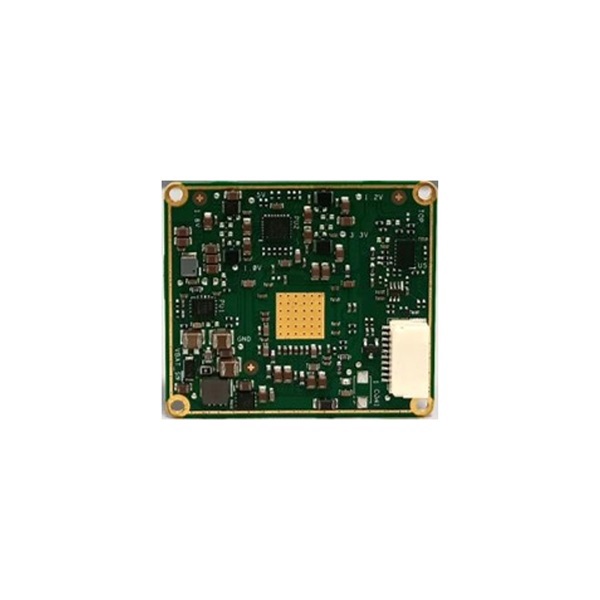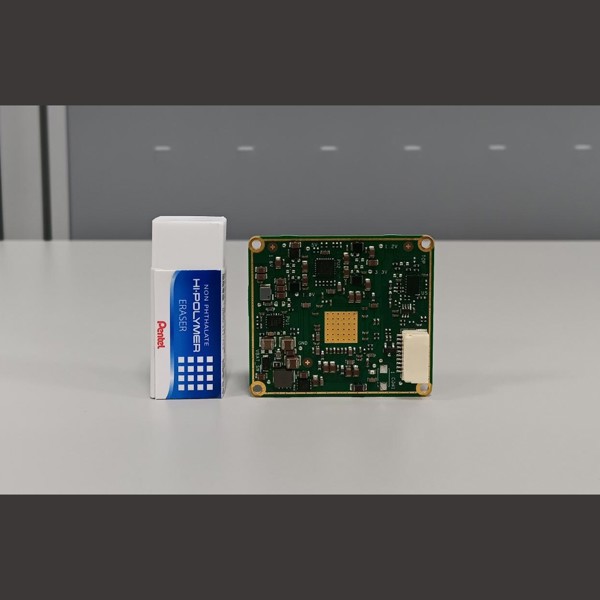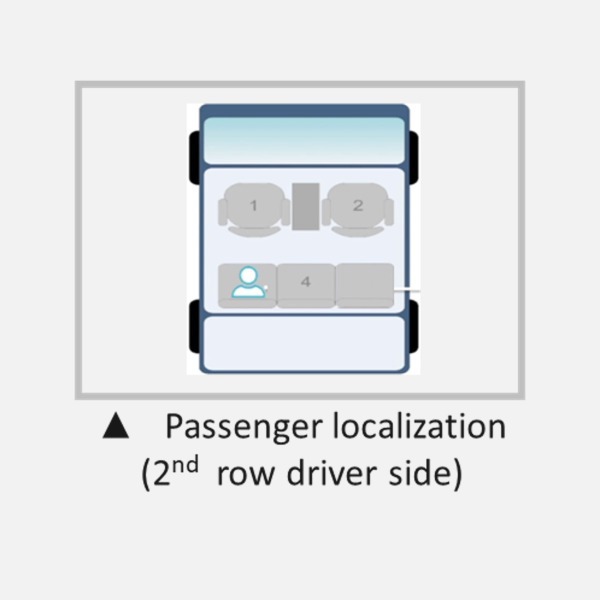- mmWave CPD utilizes radar technology on realizing compact, accurate and efficient CPD design for easy integration.
- CPD emits 60 Ghz radio signals and interprets signal reflections to provide accurate presence detection of child and adult & passenger localization.
- CPD is able to differentiate between living object and in-animated object to avoid false alarm by detecting the slightest motions of an occupant.
- With high sensitivity and wide FoV (Field of View), it can detect sleeping babies in car seats and provide wide coverage up to 2 row-seats includes foot-well.
- Designed with high accuracy & short response time (<10s), CPD is fully compliant with Euro NCAP Child Presence Detection standards.
- Prototype PCBA size is 45mm x 40mm
- shou_yu@unimax.com.tw
- +886-2-2897-0689
History of Child Presence Detection (CPD)
Child Presence Detection (CPD) is a vehicle safety technology designed to prevent children from being trapped in cars and dying from heatstroke. Child Presence Detection (CPD) technology uses in-car sensors and external communication technology to detect whether there is a child in the car and issue a warning signal to alert the driver for timely rescue. Currently, CPD has been introduced into many high-end car models by car manufacturers and is expected to become a standard configuration in the automotive industry in the future.
In order to promote and popularize Child Presence Detection (CPD) technology, the US Congress proposed the "Hot Cars Act", which requires the National Highway Traffic Safety Administration to develop technical specifications to ensure that the Child Presence Detection (CPD) function of vehicles is reliable, accurate, and easy to use. Under this bill, manufacturers of future cars manufactured or imported must install CPD technology.
In the United States, the popularity of Child Presence Detection (CPD) technology is still not enough, and dozens of children still die in hot cars every year. Therefore, some institutions and non-profit organizations have begun to promote the popularization of Child Presence Detection (CPD) technology and urged the government to strengthen the implementation and enforcement of relevant laws and regulations.
In addition to the United States, Europe has also begun to pay attention to the promotion and application of Child Presence Detection (CPD) technology. The European Union has included Child Presence Detection (CPD) technology as one of the standard configurations for "Euro NCAP 2025", requiring all new vehicles to be equipped with Child Presence Detection (CPD) technology to obtain the highest safety rating.
In summary, the application of Child Presence Detection (CPD) technology will effectively prevent tragedies of children being trapped in vehicles and dying of heatstroke, and has already received attention and promotion in places such as the United States and Europe. Related regulations are also constantly being improved and strengthened to ensure the popularization and use of Child Presence Detection (CPD) technology on vehicles. However, for consumers, the popularization of Child Presence Detection (CPD) technology still requires time and effort. Currently, Child Presence Detection (CPD) technology is still a high-end configuration in the market, with a higher price and only a few car models equipped with it. In the future, with the continuous advancement of technology and the decrease in costs, Child Presence Detection (CPD) technology is expected to gradually popularize in more car models, thereby providing more comprehensive and reliable protection for the safety of children.
UniMax mmWave Child Presence Detection (CPD)
UniMax's mmWave Child Presence Detection (CPD) is a solution to address automotive safety issues. This innovative product uses advanced radar technology to emit 60 GHz wireless signals and interpret the reflected signal to accurately locate children, adults, and passengers.
One of the features of Child Presence Detection (CPD) is that it can distinguish between living and non-living objects, avoiding false alarms. It can detect the slight movements of occupants, including the faint movements of sleeping infants in car seats. The high sensitivity and wide field of view of Child Presence Detection (CPD) can cover up to two rows of seats, including the footwell. This makes Child Presence Detection (CPD) an extremely practical and efficient solution, especially for families concerned about car safety.
In addition, Child Presence Detection (CPD) has high accuracy and short response time (<10 seconds) and fully complies with the European New Car Assessment Program (Euro NCAP) child detection standard for cars. This means that Child Presence Detection (CPD) will become a reliable and safe solution, especially as future automotive safety standards become increasingly stringent.
Finally, the PCBA size of Child Presence Detection (CPD) is 92mm x 49mm, making it easy to integrate into existing vehicle safety systems. Overall, mmWave Child Presence Detection (CPD) is an excellent and reliable product that will become an important component of future automotive safety.
mmWave Child Presence Detection (CPD) Application Scenarios
Family car
CPD can accurately detect the location and status of passengers inside a vehicle, which can help parents better ensure the safety of their children, especially in busy lives where they may sometimes forget that their child is still inside the car. The use of CPD can bring higher levels of safety and convenience to family vehicles.
Rental cars
For rental companies, CPD technology can ensure the safety of all passengers during the rental period, improving the company's reputation and customer satisfaction. When rental car customers use the vehicle, CPD can ensure their safety. Additionally, when users return the vehicle, CPD can detect if there are any individuals left inside the car.
Public transportation
In public transportation, CPD can help drivers detect if passengers have exited the vehicle, ensuring that the vehicle starts on time and maintains a punctual schedule.
School buses
On school buses, CPD technology can ensure the safety of students, especially when transporting them to and from school. School buses often operate in crowded and noisy environments, making safety crucial. CPD can detect if children are still inside the bus, ensuring that all students have exited and avoiding any potential accidents.
Commercial vehicles
In commercial vehicles, such as delivery trucks or taxis, many important goods or items may be stored inside the vehicle. However, when parked, vehicles are often targeted by thieves, and goods or items may face the risk of theft or loss.
In this case, CPD technology can provide a safety measure. Since CPD can accurately identify objects inside the vehicle and distinguish between living and non-living objects, it can monitor goods or items inside the vehicle and issue an alarm when any unusual activity or unauthorized individuals are detected, reminding drivers or vehicle owners to take timely action.
This safety measure can effectively prevent theft or loss of goods or items inside commercial vehicles, improving the safety performance of the vehicle and ensuring operational efficiency and customer satisfaction.
mmWave Child Presence Detection (CPD) Alert Process
1.mmWave
CPD utilizes mmWave (60GHz) to detect the presence of individuals inside the vehicle.
- The transmitter (TX) emits a 60GHz mmWave signal.
- The receiver (RX) receives the reflected signal and analyzes it to determine if there are signs of life, such as subtle movements or breathing.
2.Notification Mechanism
When the system detects a person inside the vehicle, it activates multiple notification mechanisms:
2-1 Smartphone Notification (BLE)
- Sends alerts to the vehicle owner’s smartphone app via Bluetooth Low Energy (BLE) technology, reminding them that there are still passengers inside the vehicle.
2-2 Car Notification
- Sends an initial warning through the in-vehicle communication system (CAN) or other methods.
- If someone is detected, the system activates the horn or flashes the lights to alert the vehicle owner.
2-3 Rescue Notification
- If the vehicle owner does not respond to the warning in time, the system will notify rescue units via the vehicle’s remote communication system (such as e-call) to intervene quickly and ensure passenger safety.
Conclusion
The core objective of CPD is to prevent the potential dangers of children or pets being left inside the vehicle. With the high-precision detection capability of mmWave sensors and a multi-layered alert mechanism, this system effectively reduces the risk of accidents caused by extreme temperatures inside the car, enhancing overall vehicle safety.
Illustration:
Customized Alert Solution
The UniMax mmWAVE CPD can be integrated with the vehicle body through the Can Bus, providing a customized alert solution according to the requirements of the car manufacturer. This includes different time points and intervention mechanisms for the vehicle's response.
Examples of Intervention Mechanisms:
Detection Start
After the vehicle is turned off and locked, the CPD performs detection for the presence of individuals and generates detection results within 10 seconds.
Vehicle Reminder
When the CPD detects the presence of individuals left inside the vehicle, in addition to flashing lights and sounding the horn, the vehicle sends a message to alert the owner. Reminders are sent every 20 seconds.
Cooling Mechanism
If the vehicle reminder exceeds 90 seconds without being unlocked, and the temperature inside the vehicle reaches 36 degrees Celsius, the vehicle will lower the windows and activate the air conditioning.
Rescue Notification
If the vehicle remains locked and the alarm is not disarmed for more than 5 minutes, a notification will be sent to rescue units for assistance.
ALL PASS EU NCAP
The UniMax mmWAVE CPD can achieve a perfect score in the EU NCAP CPD rating, and its functionality can help customers obtain higher scores in other aspects of the EU NCAP evaluation.
| EU NCAP Ratin | UniMax CPD | |
| Child Presence Dectection | 4 | All Pass |
| Seat Belt Reminders | 1 | Assisting customers in achieving through CPD. |
| Front airbag deployment/disabling | 2 | |
| eCall occupant counting | 0.5 | |
| Total | 7.5 | |
mmWAVE CPD vs Camera CPD
|
|
mmWAVE |
Camera |
|
Privacy |
High |
Low |
|
Penetration |
Powerful |
weak |
|
Resolution |
High(distance, speed) |
Low(Detail) |
|
Detection range |
FoV range coverage |
Angle limitation (line of sight blocked) |
|
Cover with blanket |
Precision |
Difficult to identify |
|
Two-row sedan |
Full coverage from a single device |
Need multiple lenses |
|
Three-row SUV |
Single or dual device full coverage |
Need multiple lenses |
|
Light Effects |
Radar is not affected by light |
Affected by lighting brightness |
Chip Module Comparison
Category | Communication Device | Feature | Module Appearance |
OE | CANBUS |
For example: GPS positioning, enabling remote queries and control of in-car features such as air conditioning, door locks, horn activation, and vehicle location to achieve real-time rescue objectives. | PCBA: 45*40mm |
AM | BT |
| PCBA: 92*49mm |
UniMax can customize (or develop) alarm mechanisms according to customer
requirements.
UniMax uses cookies and similar technologies to perform essential online functions, analyze online activities and other functions. For detailed information, please visit UniMax Privacy Policy- 「How UniMax Uses Cookies and Similar Technologies」 .




